Flame Characteristics and Response of a High-Pressure LOX/CNG Rocket Combustor with Large Optical Access
Abstract
:1. Introduction
2. Experimental Method
2.1. Combustion Chamber
2.2. Flame Radiation Imaging
2.3. Optical Setup
2.4. Operating Conditions
3. Methodology
3.1. Flame Topology Analysis
3.2. Flame Dynamics Analysis
4. Results and Discussion
4.1. Flame Characteristics
4.2. Flame Response
5. Conclusions
Author Contributions
Funding
Acknowledgments
Conflicts of Interest
References
- Hurlbert, E.A.; Ueno, H.; Alexander, L.; Klem, M.D.; Daversa, E.; Rualt, J.-M.; Manfletti, C.; Caruana, J.-N.; Asakawa, H.; Whitley, R.J. International Space Exploration Coordination Group Assessment of Technology Gaps for LOx/Methane Propulsion Systems for the Global Exploration Roadmap. In Proceedings of the AIAA SPACE, Long Beach, CA, USA, 13–16 September 2016. [Google Scholar]
- Klem, M.D. LOX/Methane In-Space Propulsion Systems Technology Status and Gaps. In Proceedings of the Southwest Emerging Technology Symposium, El Paso, TX, USA, 1 April 2017. [Google Scholar]
- Asakawa, H.; Nanri, H.; Aoki, K.; Kubota, I.; Mori, H.; Ishikawa, Y.; Kimoto, K.; Ishihara, S.; Ishizaki, S. The Status of the Research and Development of LNG Rocket Engines in Japan. In Chemical Rocket Propulsion; De Luca, L., Shimada, T., Sinditskii, V., Calabro, M., Eds.; Springer International Publishing: Cham, Switzerland, 2016; pp. 463–487. [Google Scholar]
- Simontacchi, P.; Blasi, R.; Edeline, E.; Sagnier, S.; Ravier, N.; Espinoas-Ramos, A.; Breteau, J.; Altenhoeffer, P. Prometheus: Precursor of new low-cost rocket engine family. In Proceedings of the 8th European Conference for Aeronautics and Space Sciences, Madrid, Spain, 1–4 July 2019. [Google Scholar]
- Gill, G.; Nurick, W. Liquid rocket engine injectors. In NASA-SP-8089; National Aeronautics and Space Administration: Washington, DC, USA, 1972. [Google Scholar]
- Huzel, D.K.; Huang, D.H. Modern Engineering for Design of Liquid-Propellant Rocket Engines; American Institute of Aeronautics and Astronautics: Washington, DC, USA, 1992. [Google Scholar]
- Harrje, D.T.; Reardon, F.H. Liquid Propellant Rocket Combustion Instability; Scientific and Technical Information Office, National Aeronautics and Space Administration: Washington, DC, USA, 1972. [Google Scholar]
- Hulka, J.; Hutt, J.J. Instability Phenomenology and Case Studies: Instability Phenomena in Liquid Oxygen/Hydrogen Propellant Rocket Engines. In Liquid Rocket Engine Combustion Instability; Yang, V., Anderson, W.E., Eds.; American Institute of Aeronautics and Astronautics: Washington, DC, USA, 1995; pp. 39–71. [Google Scholar]
- Schmidt, G. Flames: Technik der Flüssigkeits-Raketentriebwerke; DaimlerChryslerAerospace: Ottobrunn, Germany, 1999. [Google Scholar]
- Hardi, J.S. Experimental Investigation of High Frequency Combustion Instability in Cryogenic Oxygen-Hydrogen Rocket Engines. Ph.D. Thesis, The University of Adelaide, Adelaide, Australia, 2012. [Google Scholar]
- Jensen, R.J.; Dodson, H.C.; Claflin, S.E. LOX/Hydrocarbon Combustion Intability Investigation. In NASA-CR-182249; Rockwell International Corp.: Milwaukee, WI, USA, 1972. [Google Scholar]
- Salgues, D.; Mouis, A.-G.; Lee, S.-Y.; Kalitan, D.; Pal, S.; Santoro, R. Shear and Swirl Coaxial Injector Studies of LOX/GCH4 Rocket Combustion Using Non-Intrusive Laser Diagnostics. In Proceedings of the 44th AIAA Aerospace Sciences Meeting and Exhibit, Reno, NV, USA, 9–12 January 2006. [Google Scholar]
- Locke, J.; Pal, S.; Woodward, R. Chamber Wall Heat Flux Measurements for a LOX/CH4 Propellant Uni-Element Rocket. In Proceedings of the 43rd AIAA/ASME/SAE/ASEE Joint Propulsion Conference and Exhibit, Cincinnati, OH, USA, 8–11 July 2007. [Google Scholar]
- Hulka, J.R.; Jones, G.W. Performance and Stability Analyses of Rocket Thrust Chambers with Oxygen/Methane Propellants. In Proceedings of the 46th AIAA/ASME/SAE/ASEE Joint Propulsion Conference and Exhibit, Nashville, TN, USA, 25–28 July 2010. [Google Scholar]
- Banuti, D.; Raju, M.; Ma, P.C.; Ihme, M.; Hickey, J.-P. Seven questions about supercritical fluids–towards a new fluid state diagram. In Proceedings of the 55th AIAA Aerospace Sciences Meeting, AIAA 2017-1106, Grapevine, TX, USA, 9–13 January 2017. [Google Scholar]
- Richecoeur, F.; Scouflaire, P.; Ducruic, S.; Candel, S. High-Frequency Transverse Acoustic Coupling in a Multiple-Injector Cryogenic Combustor. J. Propuls. Power 2006, 22, 790–799. [Google Scholar] [CrossRef]
- Hardi, J.S.; Beinke, S.K.; Oschwald, M.; Dally, B.B. Coupling of Cryogenic Oxygen-Hydrogen Flames to Longitudinal and Transverse Acoustic Instabilities. J. Propuls. Power 2014, 30, 991–1004. [Google Scholar] [CrossRef]
- Beinke, S.K. Anaylses of Flame Response to Acoustic Forcing in a Rocket Combustor. Ph.D. Thesis, The University of Adelaide, Adelaide, Australia, 2017. [Google Scholar]
- Fiala, T.; Sattelmayer, T. Heat release and UV–Vis radiation in non-premixed hydrogen–oxygen flames. Exp. Fluids 2015, 56, 144. [Google Scholar] [CrossRef]
- Fiala, T.; Sattelmayer, T.; Gröning, S.; Hardi, J.; Stützer, R.; Webster, S.; Oschwald, M. Comparison Between Excited Hydroxyl Radical and Blue Radiation from Hydrogen Rocket Combustion. J. Propuls. Power 2017, 33, 490–500. [Google Scholar] [CrossRef]
- Hakim, L.; Ruiz, A.; Schmitt, T.; Boileau, M.; Staffelbach, G.; Ducruix, S.; Cuenot, B.; Candel, S. Large Eddy Simulations of Multiple Transcritical Coaxial Flames Submitted to a High-Frequency Transverse Acoustic Modulation. Proc. Combust. Inst. 2015, 35, 1461–1468. [Google Scholar] [CrossRef]
- Urbano, A.; Douasbin, Q.; Selle, L.; Staffelbach, G.; Cuenot, B.; Schmitt, T.; Ducruix, S.; Candel, S. Study of Flame Response to Transverse Acoustic Modes from the LES of a 42-Injector Rocket Engine. Proc. Combust. Inst. 2017, 36, 2633–2639. [Google Scholar] [CrossRef]
- Suslov, D.; Hardi, J.S.; Oschwald, M. Full length visualization of liquid oxygen disintegration in a single injector sub-scale rocket combustor. Aerosp. Sci. Technol. 2019, 86, 444–454. [Google Scholar] [CrossRef]
- Knab, O.; Riedmann, H.; Ivancic, B.; Höglauer, C.; Frey, M.; Aichner, T. Consequences of modeling demands on numerical rocket thrust chamber flow simulation tools. Prog. Propuls. Phys. 2019, 11, 317–346. [Google Scholar]
- Martin, J.; Armbruster, W.; Stützer, R.; General, S.; Knapp, B.; Suslov, D.; Hardi, J. Flame characteristics of a high-pressure LOX/H2 rocket combustor with large optical access. Case Stud. Therm. Eng. 2021, 28, 101546. [Google Scholar] [CrossRef]
- Haberzettl, A.; Suslov, D.; Brümmer, G.; Frank, A.; Oschwald, M. European Technology Test Facility for High Pressure Combustion P8. 20 Years Reserach and Technology Development; Deutscher Luft-und Raumfahrtkongress (DLRK): Braunschweig, Germany, 2016. [Google Scholar]
- Fdida, N.; Vingert, L.; Ordonneau, G.; Ristori, A.; Brossard, C.; Stützer, R.; Sender, J. Characterization of a Double Swirl Injector in a LOX/LCH4 Fueled Combustor on Mascotte Test Bench. In Proceedings of the 5th European Conference for Aeronautics and Space Sciences, Munich, Germany, 1–5 July 2013. [Google Scholar]
- Fiala, T. Radiation from High Pressure Hydrogen-Oxygen Flames and its Use in Assessing Rocket Combustion Instability. Ph.D. Thesis, Technical University of Munich, Munich, Germany, 2015. [Google Scholar]
- Kathrotia, T.; Fikri, M.; Bozkurt, M.; Hartmann, M.; Riedel, U.; Schulz, C. Study of the H + O + M Reaction Forming OH*: Kinetics of OH* Chemiluminescence in Hydrogen Combustion Systems. Combust. Flame 2010, 157, 1261–1273. [Google Scholar] [CrossRef]
- Leo, M.D.; Saveliev, A.; Kennedy, L.A.; Zelepouga, S.A. OH and CH Luminescence in Opposed Flow Methane Oxy-Flames. Combust. Flame 2007, 147, 435–447. [Google Scholar]
- Kojima, J.; Ikeda, Y.; Nakajima, T. Spatially resolved measurement of OH*, CH*, and C2* chemiluminescence in the reaction zone of laminar methane/air premixed flames. Proc. Combust. Inst. 2000, 28, 1757–1764. [Google Scholar] [CrossRef]
- Gaydon, A.G.; Wolfhard, H.G. Flames: Their Structure, Radiation, and Temperature; Chapman & Hall: London, UK, 1953. [Google Scholar]
- Padley, P.J. The origin of the blue continuum in the hydrogen flame. Trans. Faraday Soc. 1960, 56, 449–454. [Google Scholar] [CrossRef]
- Gaydon, A.G. Hydrogen Flames. In The Spectroscopy of Flames; Springer: Dordrecht, The Netherlands, 1974; pp. 99–126. [Google Scholar]
- Kendrick, D.; Herding, G.; Scouflaire, P.; Rolon, C.; Candel, S. Effects of a Recess on Cryogenic Flame Stabilization. Combust. Flame 1999, 118, 327–339. [Google Scholar] [CrossRef]
- Urbano, A.; Selle, L.; Staffelbach, G.; Cuenot, B.; Schmitt, T.; Ducruix, S.; Candel, S. Exploration of Combustion Instability Triggering Using Large Eddy Simulation of a Multiple Injector Liquid Rocket Engine. Combust. Flame 2016, 169, 129–140. [Google Scholar] [CrossRef]
- Schulze, M. Linear Stability Assessment of Cryogenic Rocket Engines. Ph.D. Thesis, Technical University of Munich, Munich, Germany, 2016. [Google Scholar]

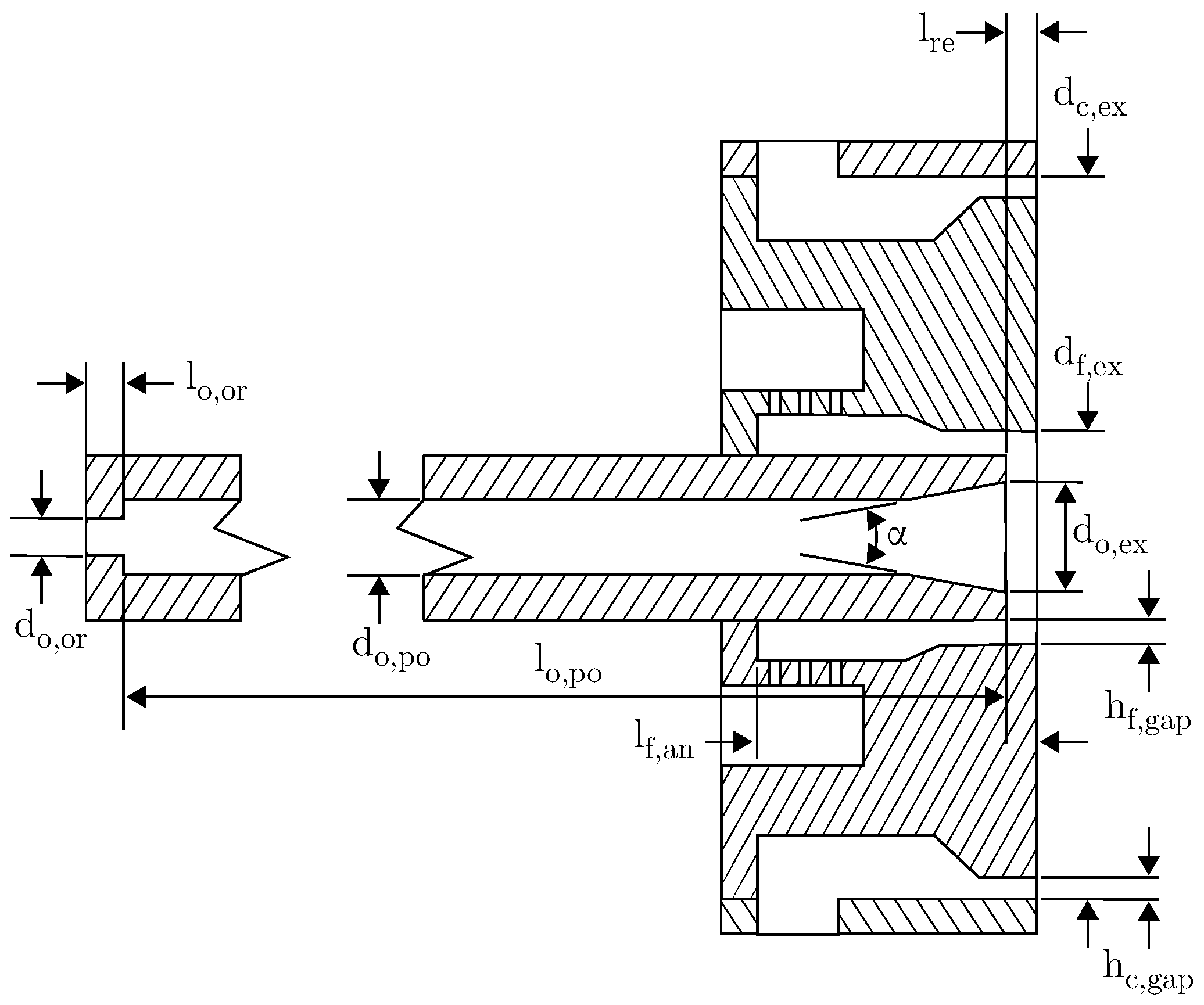


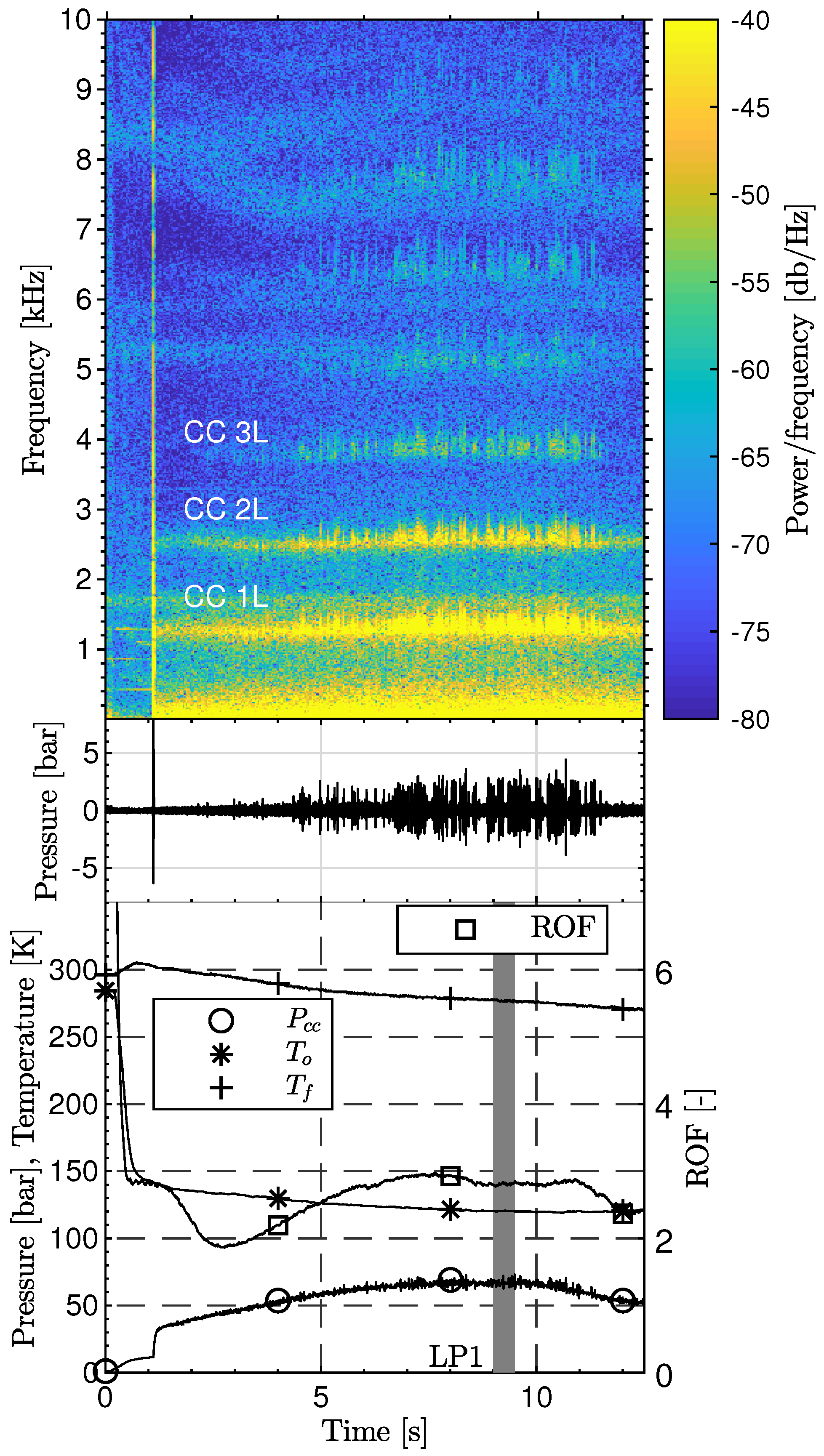
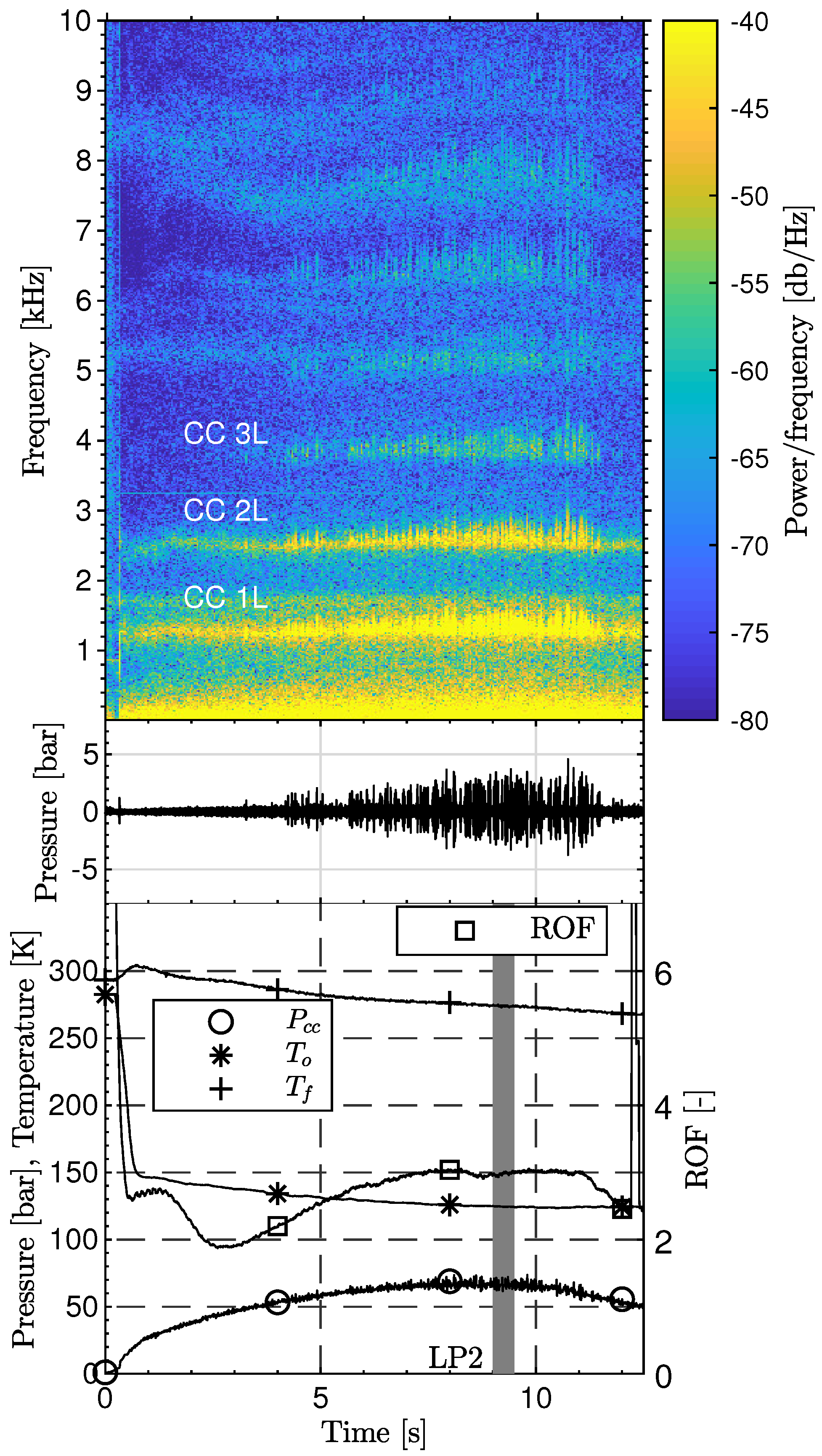
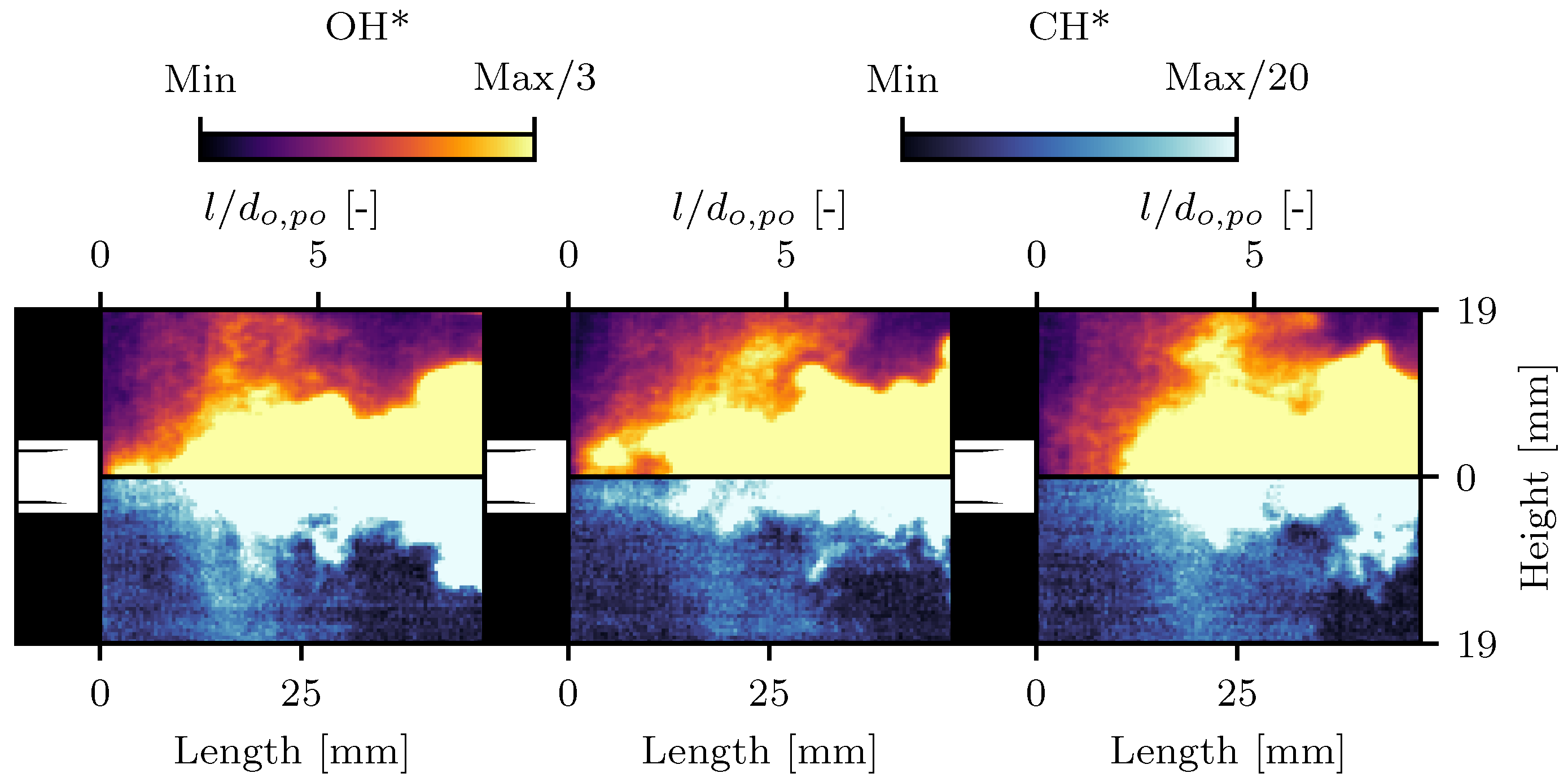


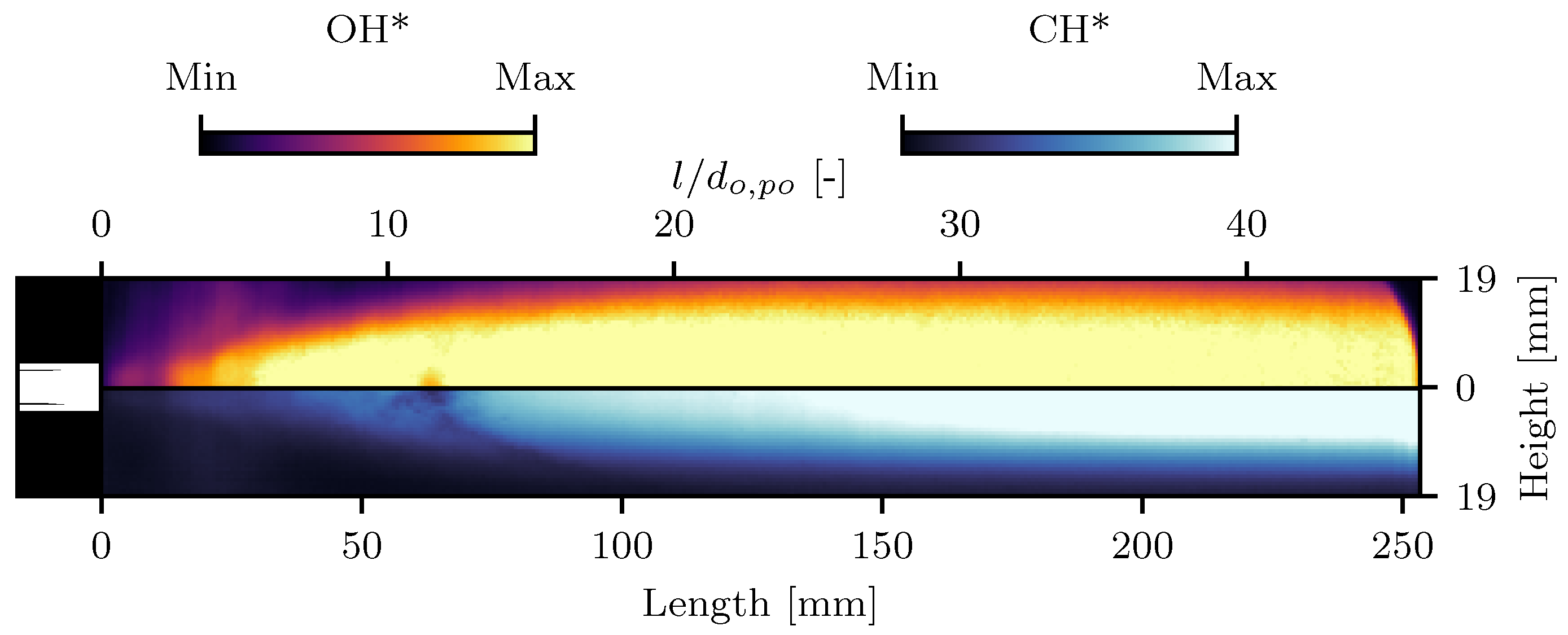







| Symbol | ||||
| Unit | mm | mm | mm | mm |
| Value | 2.2 | 4.0 | 5.5 | 127.0 |
| Symbol | ||||
| Unit | mm | ° | mm | mm |
| Value | 6.3 | 8 | 34.5 | 8.2 |
| Symbol | ||||
| Unit | mm | mm | mm | mm |
| Value | 0.5 | 50.0 | 0.4 | 4.0 |
| Parameter | Unit | Load Point | Uncertainty | |
|---|---|---|---|---|
| 1 | 2 | |||
| bar | 66.8 | 66.2 | ||
| ROF | 2.8 | 3.0 | ||
| kg/s | 0.362 | 0.365 | ||
| kg/s | 0.129 | 0.123 | ||
| kg/s | 0.298 | 0.290 | ||
| K | 121 | 125 | K | |
| K | 279 | 277 | K | |
| K | 280 | 277 | K | |
| Parameter | Unit | Load Point | |
|---|---|---|---|
| 1 | 2 | ||
| 17.1 | 15.6 | ||
| J | 15.8 | 13.6 | |
| OH* | |||
| Opening angle | ° | 16 ± 8 | 28 ± 12 |
| CH* | |||
| Opening angle | ° | 12.5 ± 6.5 | 9.5 ± 5.5 |
| Flame width | mm | 20.3 ± 0.2 | 19.0 ± 0.2 |
Publisher’s Note: MDPI stays neutral with regard to jurisdictional claims in published maps and institutional affiliations. |
© 2022 by the authors. Licensee MDPI, Basel, Switzerland. This article is an open access article distributed under the terms and conditions of the Creative Commons Attribution (CC BY) license (https://creativecommons.org/licenses/by/4.0/).
Share and Cite
Martin, J.; Armbruster, W.; Suslov, D.; Stützer, R.; Hardi, J.S.; Oschwald, M. Flame Characteristics and Response of a High-Pressure LOX/CNG Rocket Combustor with Large Optical Access. Aerospace 2022, 9, 410. https://doi.org/10.3390/aerospace9080410
Martin J, Armbruster W, Suslov D, Stützer R, Hardi JS, Oschwald M. Flame Characteristics and Response of a High-Pressure LOX/CNG Rocket Combustor with Large Optical Access. Aerospace. 2022; 9(8):410. https://doi.org/10.3390/aerospace9080410
Chicago/Turabian StyleMartin, Jan, Wolfgang Armbruster, Dmitry Suslov, Robert Stützer, Justin S. Hardi, and Michael Oschwald. 2022. "Flame Characteristics and Response of a High-Pressure LOX/CNG Rocket Combustor with Large Optical Access" Aerospace 9, no. 8: 410. https://doi.org/10.3390/aerospace9080410







